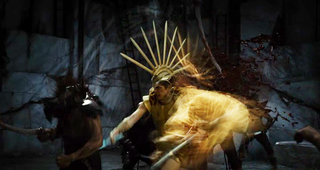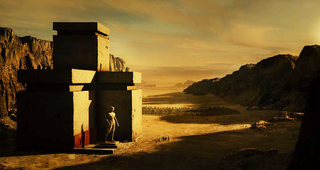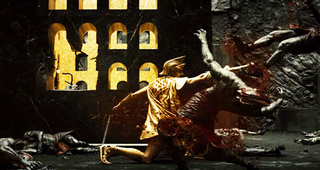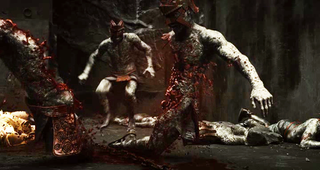
Jay Randall is a man who like an exploding head or two. As SFX chats to the second unit visual FX designer on Greek myth fantasy epic Immortals (out on DVD and Blu-ray on Monday) the subject of exploding heads comes up time and time again. Ask him his personal favourite FX shot from the film, and says without hesitation, “Oh the exploding heads.” We wonder whether he’s been affected by Scanners as a child, and he chuckles before admitting, “I did actually watch it for reference, but I don’t the techniques they used had much relevance on this film.”
He’s not joking. Whereas Cronenberg probably spent a couple of days setting up and shooting the iconic shot from his 1981 film, the major exploding heads sequence in Immortals too six months to complete, he reveals. But you get the feeling he loved every second of it.

You’re credit on the film is “Visual FX Supervisor, Second Unit”. What exactly did that entail?
“It probably best if I explain how I ended up on the film. Raymond Gieringer was the main supervisor on the show. And he and I have been working together for years, because I own a visual FX vendor shop in Montreal. So what happened was, once they decided to shoot Immortals in Montreal, he phoned me up and asked me if I would be the visual effects supervisor for the second unit. But then I was also visual effects supervisor for the post production work on various scenes that was done at my own company. So I wore two hats, sorta.
“So in preproduction, I designed a bunch of the sequences with the director, and then while we were shooting it, I basically hung out with the director – Tarsem Singh – making sure that we got all of the shots that needed visual effects shot properly so that we could do the FX later in a smooth way.
“Also, second unit often – on a film like Immortals – does all the difficult, time-consuming stuff, like for example, if there was a really intricate stunt that required a lot of visual FX. I would do most of the technical visual effects shooting, essentially”.

Was there a lot of work done on virtual, CG sets?
“Quite a bit, but we tried to limit things. On Immortals there were so many visual FX – the amount was massive – so we had to figure out ways to make the budget work. And one of the ways we did that was to contain sets. So, for example, instead of a battle happening out in the open, we would have it happen in a place where there were walls and a roof so we wouldn’t have to have set extensions on every single shot. That was one of the strategies we used.
“So there were a bunch of scenes where there were not that many visual FX, but there were other scenes where every single shot is a visual effects shot.”

Tarsem Singh is renowned for his unique, lavish visual style. Did that help or hinder in the creation of the FX in any way?
“I would say that neither. It was just sort of an artistic direction. And that’s the fun thing about working with Tarsem, because he’s really high energy, and a funny guy too. And he understands visual FX really well because he’s got a lot of experience shooting with that kind of stuff. So that just made the process a lot easier. And for us I don’t think it really mattered that much whether he wanted it darker, lighter, bluer, greener, because we can do anything, you know?
“The hard parts are when you’re doing something and there’s a whole bunch of intricate shooting that you have to do. That takes time. For example, there’s a scene in Immortals where Ares is up in Mount Olympus and Theseus is in a quarry and he’s been ambushed by the bad guys. Ares decides he doesn’t want this to happen, comes down to Earth…
“Now, the Gods move so much faster than the humans. Tarsem described it as they were moving so fast the humans would look like they were almost standing still. So in that scene, Ares is moving super-quickly while the humans are standing still. So we had to actually film that in a whole bunch of different layers. We filmed Ares on green screen with a real-time camera, and then we filmed all the bad guys separately on a super high speed camera so it would look like they were moving in incredibly slow motion.
“Then we had to layer it all together. Ares comes through with his war hammer and knocks all their heads into oblivion. So they’re heads are blowing up in slow motion. It was quite a stunning sequence, and that was done at my company in Montreal.
“On set I would film all of that. I would design all the different layers and how to film them, so that we had all the technical specifications correct. And then after that I would go back to my studio where we would simulate all those heads exploding and put together all those layers.”

It’s hard not to compare the film with 300 – it even has the same producers – but has effects technology moved on massively since then?
“I think probably back then most of the stuff that we used on Immortals was available, but it was probably brand new. Most simply, the biggest difference between then and now is the price. There are things that back then would have been very expensive. Because then they were cutting edge new technologies, but now, because that software has been around for a few years, it’s just a little bit cheaper and more affordable. Plus the computers are a lot faster now. Which also makes things cheaper.”
So how long does it take to create the digital FX after all the live action shooting has been done?
“Little tiny things like an A over B comp – combining just two element, like an actor with some one other element – you can do that fairly quickly. Maybe in a day or two. Because you want it to be perfect, so you spend the time.
But few things are that simple. For example, those exploding heads I was talking about – we spent three days shooting that sequence and there were tonnes of different layers that we had to put together. And then we had to make the heads explode. That took about six months. It took a small team of people six months”

How many layers are we talking about?
“I think we had about ten filmed layers that we had to composite together. And then we would have had about 100 CG layers. For each exploding head we would have to render all the different blood patterns and brains and all that separately. We would even render the shadows separately – that way we could make the shadows a bit lighter or darker if necessary”
You’re teaming up with Tarsem Singh again for his next movie, Mirror, Mirror , based on Snow White…
“We’ve already wrapped all out work on that.”
What was the most fun FX challenge on that?
“One of the shots that we did that was a real challenge was a kind of a Benjamin Button thing, where we made Julia Roberts – The Evil Queen – look 90 years old, for when she becomes the old hag who gives Snow White the apple. I think it’s turned out really well.”
Immortals is out on 3D Blu-ray, Triple Play Blu-ray, DVD and
download from 5 March 5. Pre-order your copy now at www.play.com

